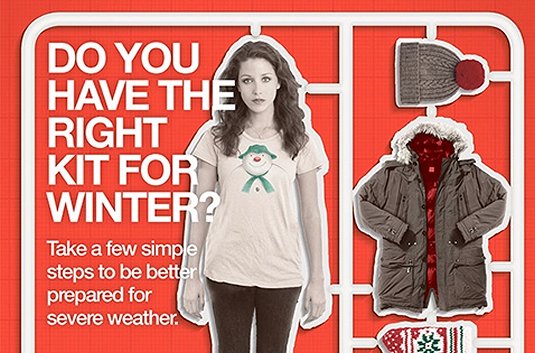
Red Cross workers on both sides of Atlantic grapple with brutal winter

7 January 2014
Countries on both sides of the North Atlantic continue to face very severe winter weather that produced what the US National Weather Service this week called “dangerously low temperatures”, and the UK Met Office – in its official blog – described as “the stormiest December in records dating back to 1969 and…one of the windiest calendar months for the UK since January 1993.”
The Met Office also said Scotland had its wettest month in records dating back to 1910.
Extreme winter weather on both sides of the Atlantic have triggered special measures by the Red Cross societies involved.
The American Red Cross (ARC) said it was assisting people affected by bitterly cold temperatures “covering two-thirds of the country” and it is urgently providing detailed advice on how people can stay safe.
The Red Cross was operating emergency shelters in at least 15 US states and working with local officials to respond quickly, as the cold weather moved generally east and south.
“Officials report as many as 117 million people are living under dangerous wind chill warnings, advisories and watches,” said the ARC website.
Emergency kit
In the UK, where persistent storms, floods and tidal surges rather than extreme cold have posed hazards, three severe flood warnings (meaning danger to life) were in force early this week in the county of Dorset, as well as many lower-level warnings in other parts of England and Wales.
The British Red Cross (BRC) Ready for winter web page points out that severe weather “can strike quickly and cause major disruption to our homes, families and communities”.
The National Society says it’s working with the UK and Scottish governments to help people prepare for sudden snow, storms, floods and other winter emergencies.
It advises people to prepare an emergency kit with essentials for the home and car; it also suggests staying informed by checking warnings from the Met Office and reading Red Cross information about flooding and first aid.
The most common winter extremes in Canada are blizzards and ice storms, according to the Canadian Red Cross (CRC) advice page.
“An ice storm is caused by freezing rain accumulating on the ground and on other surfaces such as cars, electrical wires and street signs,” it adds.
A severe ice storm hit Canada’s largest city, Toronto, and much of the east of the country late last month, leaving hundreds of thousands of people without electricity.
The CRC helped affected people by providing warming shelters as well as hot food and hygiene kits.
The British Met Office blog said “there’s currently no evidence to suggest that the UK is increasing in storminess [but] this is an active area of research under the national climate capability.”
Climate connection?
On average, global warming is generally decreasing the likelihood of events like the cold wave in North America, but some studies show that paradoxically climate change could have played a role in the current weather.
The North Pole is warming faster than the equator, which affects the jet stream – the strong current of upper winds in the northern hemisphere.
In turn that changes the risk of particular extremes such as the cold polar air now extending across North America. But the possible links are still the subject of ongoing research and scientific debate.
“From the humanitarian perspective, the crucial thing is preparedness rather than whether these unusual winter extremes can be attributed to climate change or not,” says Dr Maarten van Aalst, Director of the Climate Centre.
“On the shortest timescales, a hazard is a hazard. Science may eventually be able to tell us with confidence which extremes are most likely to multiply over time and where.
“But we have to be equally ready to meet all extremes – whether natural or identifiably caused by humans.”
'Ice quakes'
The harsh winter across the North Atlantic has been popularizing a new winter lexicon through forecasts and warnings on broadcast media.
British meteorologists have been talking about “weather bombs” to describe an exceptionally rapid drop in pressure at the centre of a storm; the “polar vortex” currently affecting much of the US is believed to be the most severe of its kind for two decades.
And one explanation put forward for the loud bangs heard in the Toronto area over Christmas is that they were cryoseisms or “ice quakes”, caused by the cracking of frozen soil and rock as water freezes and expands within it.
A British Red Cross Ready for winter poster reminds people to wrap up well against the cold. (Graphic: Robin Stannard/BRC)